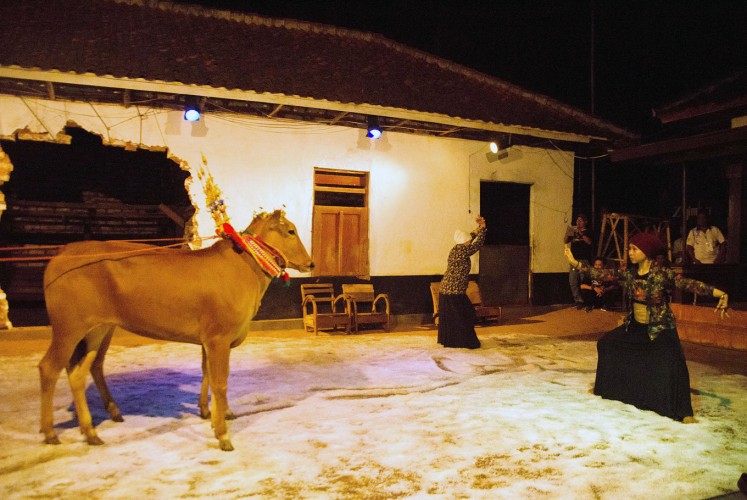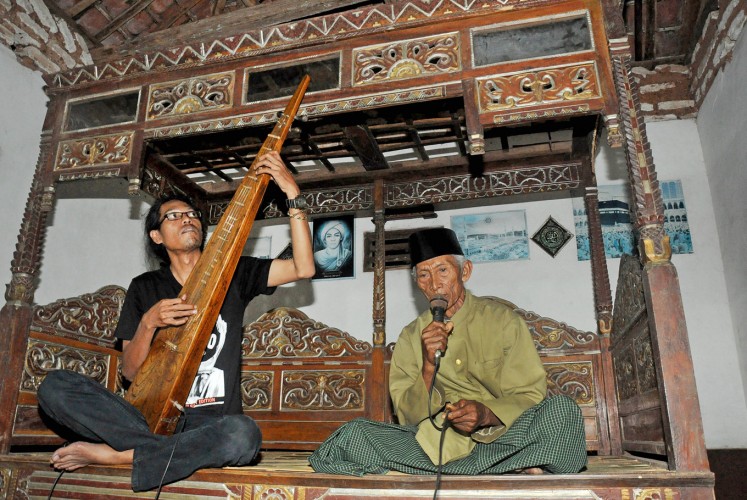Popular Reads
Top Results
Can't find what you're looking for?
View all search resultsPopular Reads
Top Results
Can't find what you're looking for?
View all search resultsEmbracing identity
A story about being Madurese is presented uniquely in the front yard of a home.
Change text size
Gift Premium Articles
to Anyone
P
lay director and actor Anwari experimented when his play Taténgghun (The Show) was staged in Balowar, Nyapar village, Dasuk district, Sumenep regency, recently.
The young native of Madura used cows, cowsheds and hay, nanggala (wooden plows), stretches of salt and bamboo ladders to create the setting.
His play began with two decorated cows pacing gracefully in a yard swathed in salt, to the accompaniment of saronen (Madurese gamelan with a wooden trumpet) sapek ( string instrument) and mamaca (sung poetry of Madura).
Pusa’e, a mamaca artist from Sumenep in his 70s, performed with prime vocal articulation while sitting on a Madurese wood-carved bed.
Two female actors performed the village women’s daily activities and used brass bells for cows to explore the characters. Meanwhile, three other actors shouldered wooden plows to act out paddy plowing. At the end of the scenes that lasted about 60 minutes, Anwari kneeled to wash the feet of three women of three ancestral generations.
The audience consisted of locals and a number of visitors, who were crowding housing terraces around the stage for a better view. Anwari designed this show to suit whatever space available.
“Family members also became part of the theater,” he said.
He said the show adopted an anthropological concept initiated by Italian theater director Eugenio Barba. Under the concept, the creative process and materials of the play are centered on villages, natural environment and families.
Real life on stage: The show's props include cows and salt, which are inseparable from the life of Madurese people. Anwari introduces the anthropological theater concept during a performance in his hometown, in which the stage setting is focused on villages, natural environs and family members. (JP/Nedi Putra AW)In Taténgghun, Anwari tried to introduce the culture of Madura, personal and communal. The cultural manifestation was prompted by his spirit emanating from the historical moments of his life from childhood up to the present.
The actor, a member of the Suzuki Company of Toga (SCOT), a professional theater network in Japan, said the story was inspired by his own experiences, particularly being born in a cowshed.
The only child said he had a personal reason for using the anthropological theater concept in the show.
“My father was enraged when I planned to study dance drama and music at Surabaya State University because the department was seen as unsuited for a villager,” he said.
Nonetheless, Anwari was persistent in his pursuit although he had to leave home for two years. When he heard the news of his ailing mother, he returned home and attempted to resume his communication with his father, who finally began to understand and gave him his blessings to pursue his career choice.
Anwari gradually acquainted his family members and neighborhood with dramatic arts by showing them theater videos on his laptop.
The concept of anthropology in theater also enables him to be flexible because his native village has limited theatrical access, unlike mainland Java, where stage facilities, actors, directors and various properties are widely available.
“The other reason for choosing anthropological theater is that it can be performed anywhere, not necessarily on a real stage, by using any property and you can collaborate with anybody,” he said.
Soulful: Pusa’e (right) sings Madurese poetry or mamaca during the play. (JP/Nedi Putra AW)Having such a natural setting also gives another advantage in terms of audience because people in the village usually look for entertainment, therefore Anwari and his team did not have to secure a big audience.
In their month-long training, Anwari and the other actors interacted with the residents so as not to create any distance.
“It’s improper for a performance to be understood only by its actors,” he added.
Born in Sumenep on April 2, 1992, Anwari said it would not be right to gain international fame without being familiar with his place of origin.
His Taténgghun show involved artists from Sumenep and East Java cities of Malang, Surabaya and Trengggalek, including his wife and other family members. Among them were Swandayani Tedja, a dancer and dance instructor who took part in an art mission to Yemen in 1998, and Dian Bokir, a dancer who has performed in Germany, Singapore and Japan.
Anwari plans to present the production next year with the same story and in the same place, but it will be redesigned. He hopes that this anthropological approach can be followed by other artists or directors.
“Every village can feature its characteristics like agriculture for agrarian areas or fisheries for coastal regions,” he said.













